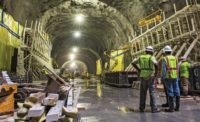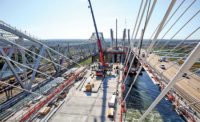Technology Helps Bridge Span a River and the Next Century


Hanging High Strain gauges, anemometers, tiltometers and more are embedded into the superstructure or attached to bridge components. Photo courtesy of New York State Thruway Authority

Taking Care A dozen kinds of sensors will inform bridge authorities about potential conditions and problems. Image courtesy of New York State Thruway Authority

Wide Span Traffic shifts onto one span of the new bridge this year, but data from sensors will be flowing before that. Photo courtesy of New York State Thruway Authority

Hard at Work As superstructure completion is underway, the work includes hard-wiring sensors to data collection units. Photo courtesy of New York State Thruway Authority





When South Nyack, N.Y., Mayor Bonnie Christian rode her bike as a child across the Tappan Zee Bridge at its grand opening more than six decades ago, she had little idea she would one day witness construction of the $4-billion, 3.1-mile structure that would replace it. “You personally never thought of a time span on it,” she says.
The New York State Thruway Authority’s ambition is for the new two-span bridge crossing the Hudson River 25 miles north of New York City to have a 100-year useful life—so the South Nyack mayor who welcomes the next bridge probably isn’t even born yet.
Should the current replacement achieve that century mark, it will likely owe its longevity to a battery of smart technology systems—sensors, gauges, monitors, data reporting tools and more—that aim to ensure that the structure operates smoothly and safely on a day-to-day basis and doesn’t need its core components replaced or repaired for its entire life.
“We’ll have strain gauges, anemometers, tiltometers—we’re measuring movement where we think it’s important, for strains or forces that we think we need to monitor, obviously for the health of the bridge,” says Jamey Barbas, project director for what is officially called the New NY Bridge Project. “If there are huge winds, we’ll be alerted right away and [be able to restrict whether] trucks go over the bridge. If we see something wrong, we’re able to go out and fix it before it becomes catastrophic in terms of the work effort.”
Tappan Zee Constructors—the design-build team on the project that is anchored by Fluor Corp., American Bridge, Traylor Bros. and Granite Construction—has already installed more than 450 sensors, gauges and monitoring units on the new bridge, which is set to take all traffic from the old bridge on its northern span later this year, with both spans fully open in 2018. The team is now streamlining connection of the sensors to central data units and establishing reporting parameters with the Thruway Authority, says Marco Perez, the contractor’s program lead for facilities. “The structural monitoring system is part of the overall infrastructure for the bridge,” he says.
A Difficult Case Study
The existing Tappan Zee, which was built in 1955, is a case study in structures not built for the long haul, from either a capacity or structural standpoint. The bridge struggles to handle today’s volume of traffic—about 140,000 vehicles a day—with heavy congestion, narrow lanes and no emergency shoulders that contribute to a per-mile accident rate that is double the rest of the 570-mile New York Thruway system. It also has required hundreds of millions of dollars of basic repair in recent years and would need similar capital outlays to stay at its current level.
By contrast, the new bridge will have eight traffic lanes, another four for breakdowns and emergencies, bicycle and walking paths and future capacity to handle a mass transit crossing. And it also will be one of the most high-tech bridges in the U.S. because of its ability to monitor structural health, real-time traffic conditions and extreme loads from hurricanes or earthquakes, following the lead of others overseas, such as in Japan, Barbas says. “It’s a [cultural shift] for us, and it’s an investment,” she adds.
Introducing smart technology—and generally digitizing the world of design, construction and asset management—has been a long road, and the industry is at the early stages, says Todd Hitt, CEO of Kiddar Capital, a private equity firm that invests in new technologies for this market.
“If we see something wrong, we’re able to go out and fix it before it becomes catastrophic.”
—Jamey Barbas, Project Director, New NY Bridge
“There is a huge opportunity to fund digitized solutions for the construction industry,” he says, citing computerized design systems, geospatial radar equipment, digitized punch lists, drones for safety and security monitoring, and the corrosion and strain gauges.
So far, there is limited use of such systems in the U.S., but their use will expand thanks to regulatory requirements, site safety needs and savings and efficiencies but also as industry professionals gain more experience with these tools, Hitt says. “We should not be in a situation anymore where we don’t know whether a bridge is safe,” he says.
Even beyond its tech features, the new bridge has already marked many of its big construction milestones, including topping out of its 419-ft towers in December, completion of most of the 3,000 roadway panels and installation of nearly all support structures—including more than 120 steel girder sections and 1,000 piles.
The northern span is nearly fully built from the Westchester County shoreline to Rockland County, while the southern span awaits final connections because it overlaps with the existing Tappan Zee, which crews will start to demolish later this year. The northern span is wider in order to both handle the temporary traffic shift as well as future mass transit capacity, Barbas says, describing the plan drafted by Tappan Zee Constructors’ design team of HDR, Buckland & Taylor, AECOM/URS and GZA.
Most work that’s left is on the spans themselves, Barbas says. “It’s a great relief to be out of the water,” she says.
Testing, Testing
The switch-on date for the project’s sensors and gauges will come even sooner than the traffic this year. These systems will be on the watch for a swath of potential changes, problems and conditions.
Some will measure angular movement for structural sway and changes in tower alignment, traffic weight and vibration on the spans or stress or long-term distortions of the shape of core components.
Sensors on the cables will test for the tension in each strand and impacts from climate changes. Corrosion monitors will look for effects on material quality and composition in steel and rebar sections. Yet others will monitor wind speed and direction, air temperature and weather conditions as well as traffic volume and speed.
Sensors throughout the bridge required planning as early as the shop drawing stage to ensure materials and structural elements could accommodate the equipment.
—Marco Perez, Program Lead, Tappan Zee Constructors
The sensors fall into two categories, some embedded into the infrastructure and others post-installed, says Todd Ostendorf, a systems project engineer at Tappan Zee Constructors. The embedded class includes sensors at piers and decks to monitor girder system steel and rebar for corrosion caused by road salts and other contaminants or gauges to measure deck surface temperatures, he says. “It helps to evaluate your substructure’s integrity,” Ostendorf says.
The post-installed group includes inclinometers measuring lateral movement of the structure, accelerometers on the stay cables and sensors measuring the health of bearings, he says.
The team has deployed sensors in representative locations throughout the bridge, which required planning as early as the shop drawing stage to ensure that materials and structural elements could accommodate the equipment, Perez says. “The coordination started early on” among designers, equipment manufacturers and subcontractors, he says.
All of those monitoring units will constantly produce data flowing to the Thruway Authority’s command center, which gives the project team another big task—managing it all. The key strategies are to compile customized reports and trigger targeted notifications for specific data readings, Barbas says. “There are certain places that are known to be a little bit more interesting for bridge owners to check the strains on,” she says.
The monitors will all feed into “data acquisitioning units” installed on the bridge that also are hard-wired in most cases via fiber or copper lines to transmit out to the Thruway Authority’s operations systems, Ostendorf says. The data collecting starts soon, because the team intends to establish baselines for the structure’s conditions without traffic in order to compare with how it behaves under normal loads, Perez adds. The team is currently establishing minimum and maximum thresholds for readings that can trigger a notification, he says.
All of that information will be critical for routine maintenance planning and inspection work, Barbas says.
The data will also feed into the intelligent traffic system infrastructure that helps the operations team monitor volume, weather conditions and bridge security needs, Perez says. “Immediately, you can change the lane configurations or slow traffic down,” he says.
The team will soon set parameters for who gets what information and when it should transmit, Barbas adds. “One thing we don’t want to do is get flooded with all kinds of data that we’re overwhelmed,” she says.
100 Years
Barbas recalls how her team on a prior drawbridge project figured out a bearing had frozen by noticing that masonry on a pier moved when the span opened.
“We don’t have to wait today to see those more exaggerated effects and have a costly repair,” she says. “By computer diagnostics and these sensors, we can quickly get a reading and understanding.”
Those tools contribute greatly to the goal of making the bridge last until the next century, she says. The design-builder’s contract calls for core components to not need major maintenance over the service life, Barbas explains.
“Of course, there can be components that are obviously changed out,” she says. “But the main thing is that the towers and piers—they’re supposed to last 100 years.”








